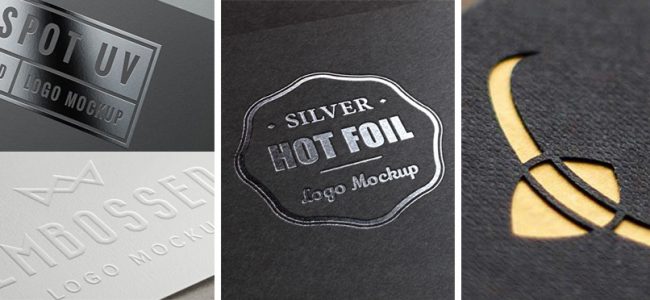Decorative processes for special finishes all contribute towards the overall look and feel of a piece of printed literature. Although often overlooked because of the additional production cost, special finishes are a great way to create distinctive and memorable print items, especially for high circulation items like business cards. All of the finishes detailed below can be applied to most pieces of print, including brochures, leaflets, book cover, business card, invitations etc.
Varnishes (Gloss & Spot UV)
Much like a wood varnish, print varnishes add a protective liquid layer over the paper stock. The varnish is applied after the printing process, but before the cutting and binding of sheets (so production and drying times can be increased). Common types of varnish include; Glossy and spot UV.
Lamination (Gloss and Matt)
A thin layer of protective plastic, which is often used on the covers of printed items to add both decorative and protective values. It may not always be visible, but is easily identifiable to the touch as it creates smooth, water-resistant finish. Common types of lamination includes; Gloss, Matt and Satin. A gloss laminate is the easiest to see, and provides a durable and shiny finish.
Embossing and Debossing
Embossing and debossing are similar finishes, where the surface is either raised or pressed into the page. This process brings a three-dimensional appeal to printed items, and works really well on business cards and cover pages. This process works very well in combination with another finish, such as foil stamping.
Die Cutting
Die cutting is a technique of cutting out shapes from stock that is used in packaging designs, brochures, folders or business cards with rounded corners. It can be produced using a steel-edged die (constructed by hand), which is fed through a printing press. Die cutting is a process by which a bespoke shape is cut away from the stock material using a cutting template called a die or forme. This technique is commonly usqed on folders, business cards and other stationary.
Foil Stamping & Metallic
Foiling is one of the most popular finishing techniques, where a metallic foil is applied with pressure to the stock using heated metal die and a hot foiling stamping machine. The finished effect creates a smooth and highly reflective surface, although matt foils are available as well. Foil stamping works brilliantly in combination with embossing, creating a three-dimensional, gleaming piece of print.
Metallic Inks These inks contain metallic components that give them a reflective quality and bright finish. Metallic inks are less lustrous than foil stamping, so if you’re looking for a highly reflective and striking finish, foils are more appropriate, whereas metallic inks provide a more subtle finish.
